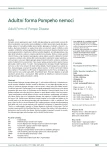Sporadic Use of Decompressive Hemicraniectomy in a Patient with Brain Abscess – a Case Report
Authors:
J. Mork 1; D. Štěpánek 1; V. Runt 1; J. Hommerová 2; V. Přibáň 1
Authors‘ workplace:
LF UK a FN Plzeň, Neurochirurgické oddělení
1; LF UK a FN Plzeň, Neurologická klinika
2
Published in:
Cesk Slov Neurol N 2014; 77/110(6): 765-768
Category:
Case Report
Podpořeno MZ ČR – RVO (Fakultní nemocnice Plzeň – FNPl, 00669806).
Overview
Brain abscess is caused by direct dissemination of inflammation from surrounding structures, remote infectious sources or is associated with brain trauma or neurosurgical procedures. Treatment includes surgical aspiration and intravenous antibiotics. Excision of the lesion is sometimes indicated. Antiedematous therapy is necessary in cases of brain oedema. At the present time, the majority of patients with brain abscesses survive and recover completely. Here we describe the case of a patient with brain abscess, whose condition deteriorated after aspiration of the lesion. The deterioration was due to progression of collateral brain oedema. After urgent decompressive craniectomy, the patient recovered completely. A cranioplasty was performed when the oedema disappeared. The abscess resolved completely following aspiration and antibiotic therapy. Fusobacterium and peptostreptococus were identified as the causative pathogens. Decompressive craniectomy has very rarely been applied in the treatment of brain abscesses and is reported sporadically.
Key words:
decompressive craniectomy – brain abscess – CNS infection
The authors declare they have no potential conflicts of interest concerning drugs, products, or services used in the study.
The Editorial Board declares that the manuscript met the ICMJE “uniform requirements” for biomedical papers.
Sources
1. Juráň V, Smrčka M, Svoboda K, Fadrus P, Šprláková A, Gál R. Indikace dekompresivní kraniektomie u traumat mozku. Cesk Slov Neurol N 2009; 72/ 105(5): 439– 445.
2. Mraček J, Mraček Z, Choc M. Poznámky k operační taktice a technice dekompresívní kraniotomie. Rozhl Chir 2007; 86(5): 217– 223.
3. Mracek J, Choc M, Mork J, Vacek P, Mracek Z. Osteoplastic decompressive craniotomy – an alternative to decompressive craniectomy. Acta Neurochirurgica 2011; 153(11): 2259– 2263. doi: 10.1007/ s00701‑ 011‑ 1132‑ 0.
4. Cooper DJ, Rosenfeld JV, Murray L, Arabi YM, Davies AR, D‘Urso P et al. Decompressive craniectomy in diffuse traumatic brain injury. N Engl J Med 2011; 364(16): 1493– 1502. doi: 10.1056/ NEJMoa1102077.
5. Vahedi K, Hofmeijer J, Juettler E, Vicaut E, George B, Algra A et al. Early decompressive surgery in malignant infarction of the middle cerebral artery: a pooled analysis of three randomised controlled trials. Lancet Neurol 2007; 6(3): 215– 222.
6. Kala M. Hnisavé záněty mozku. 1. vyd. Praha: Galén 1997.
7. Kroó M, Černoch Z, Řezáč O. Taktika léčby mozkových abscesů v éře CT – zkušenosti, problémy, perspektivy. Cesk Neurol Neurochir 1987; 50/ 83(2): 125– 134.
8. Nathoo N, Nadvi SS, van Dellen JR, Gouws E. Intracranial subdural empyemas in the era of computed tomography: a review of 699 cases. Neurosurgery 1999; 44(3): 529– 535.
9. Náhlovský et al. Neurochirurgie. 1. vyd. Praha: Galén 2006.
10. Kramer AH, Bleck TP. Neurocritical care of patients with central nervous system infections. Curr Infect Dis Rep 2007; 9(4): 308– 314.
11. Agrawal D, Hussain N. Decompressive craniectomy in cerebral toxoplasmosis. Eur J Clin Microbiol Infect Dis 2005; 24(11): 772– 773.
12. Zakaria A, Elwatidy S, Elgamal E. Nocardia brain abscess: severe CNS infection that needs aggressive management; case report. Acta Neurochir (Wien) 2008; 150(10): 1097– 1101. doi: 10.1007/ s00701‑ 008‑ 0026‑ 2.
13. Mraček J, Choc M, Mraček Z. Osteoplastická dekompresivní kraniotomie. Cesk Slov Neurol N 2007; 70/ 103(3): 290– 293.
14. Kala M. Pooperační slepota – možný následek nitrolební dekomprese? Cas Lek Cesk 1988; 127: 1494– 1496.
15. Pérez‑ Bovet J, Garcia‑ Armengol R, Buxó‑ Pujolràs M,Lorite‑ Díaz N, Narváez‑ Martínez Y, Caro‑Cardera JLet al. Decompressive craniectomy for encephalitis with brain herniation: case report and review of the literature. Acta Neurochir (Wien) 2012; 154(9): 1717– 1724. doi: 10.1007/ s00701‑ 012‑ 1323‑ 3.
16. Di Rienzo A, Iacoangeli M, Rychlicki F, Veccia S, Scerrati M. Decompressive craniectomy for medicallyrefractory intracranial hypertension due to meningoencephalitis: report of three patients. Acta Neurochir (Wien) 2008; 150(10): 1057– 1065. doi: 10.1007/ s00701‑ 008‑ 0019‑ 1.
17. Rennick G, Shann F, de Campo J. Cerebral herniation during bacterial meningitis in children. BMJ 1993; 306(6883): 953– 955.
18. Wada Y, Kubo T, Asano T, Senda N, Isono M, Kobayashi H. Fulminant subdural empyema treated with a wide decompressive craniectomy and continuous irrigation – case report. Neurol Med Chir (Tokyo) 2002; 42(9): 414– 416.
19. Ong YK, Goh KY, Chan C. Bifrontal decompressive craniectomy for acute subdural empyema. Childs Nerv Syst 2002; 18(6– 7): 340– 343.
20. Baussart B, Cheisson G, Compain M, Leblanc PE, Tadie M, Benhamou D et al. Multimodal cerebral monitoring and decompressive surgery for the treatment of severe bacterial meningitis with increased intracranial pressure. Acta Anaesthesiol Scand 2006; 50(6): 762– 765.
21. Bordes J, Boret H, Lacroix G, Prunet B, Meaudre E, Kaiser E. Decompressive craniectomy guided by cerebral microdialysis and brain tissue oxygenation in a patient with meningitis. Acta Anaesthesiol Scand 2011; 55(1): 130– 133. doi: 10.1111/ j.1399‑ 6576.2010.02355.x.
22. Hejčl A, Sameš M. Mikrodialýza v neurochirurgii. Cesk Slov Neurol N 2009; 72/ 105(6): 511– 517.
Labels
Paediatric neurology Neurosurgery NeurologyArticle was published in
Czech and Slovak Neurology and Neurosurgery

2014 Issue 6
Most read in this issue
- Diazepam i. m. – the Most Common, but Inappropriate Medication for Management of Acute Anxiety, Agitation and Aggression
- Missile Head Injury with a Replica of a Historical Weapon – Pathophysiology and a Case Study
- Adult Form of Pompe Disease
- The Five Point Test – a Test of Nonverbal Fluency: Normative Data for Adults
